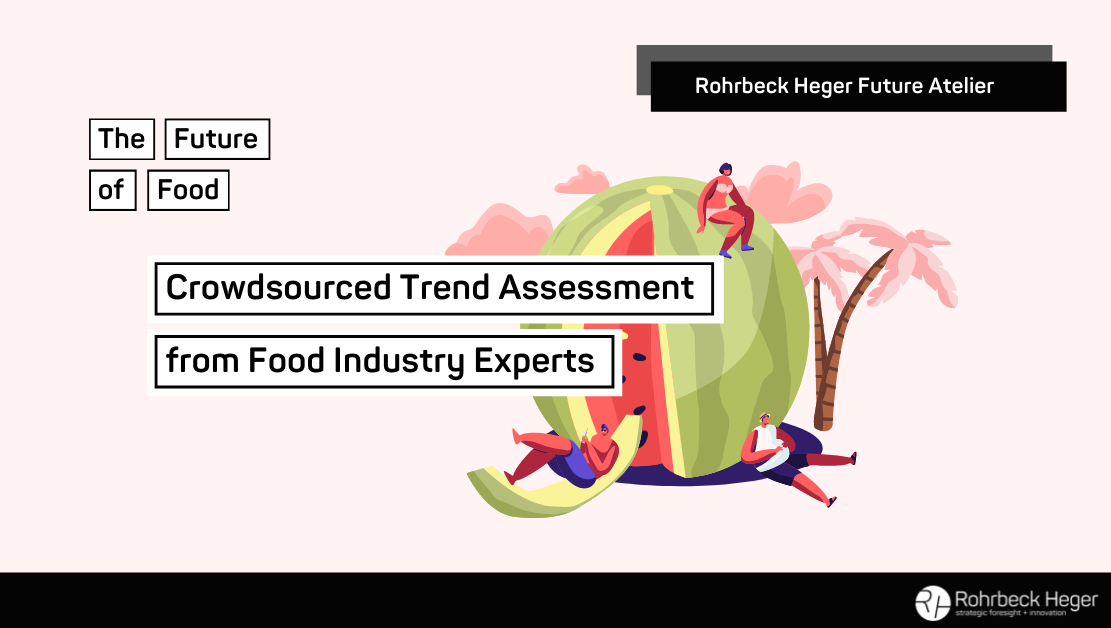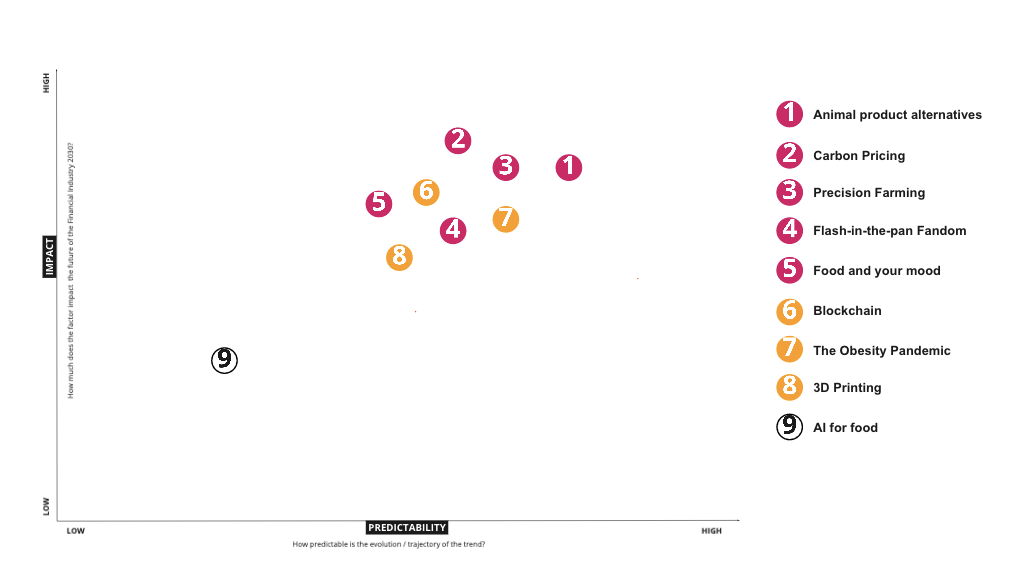
This Is Food in 2030: Crowdsourced Trend Assessment from Food Industry Experts
Our Rohrbeck Heger Future Atelier event series gathers innovation and strategy professionals to discuss future-forward foresight practice. This installment: the future of food.
Our third Rohrbeck Heger Future Atelier focussed on a tantalizing topic: the future of food. Industry experts, representing global companies such as Danone and ABInBev, as well as regional players including REWE Group and Picard, gathered from around the world for a digital discussion on major trends that will define the food industry as it heads towards 2030. Participants also learned more about what it means to implement corporate foresight practice from the perspective of global snacking powerhouse Mondelez.
Future focus from the top: Mondelez’s leadership keen on foresight
We were delighted to welcome Serhiy Kalinovsky, Senior Manager, Strategic Foresight at Mondelez, who shared how the parent company of beloved brands such as Oreo and Cadbury’s Dairy Milk has adopted a future-forward mindset. How does his lean unit leverage the power of Mondelez’s 80,000 global employees to stay relevant in a shifting world and prepare for the future?
Mondelez is committed to “looking ahead in the longer term to stay successful in the future,“ explained Kalinovsky, who credits the Fortune 500 company’s CEO Dirk Van de Put as a driving force behind this initiative. As someone who is convinced of the importance of “leading from the future,” Van de Put has pushed for an internal company culture that is focused on answering the question, “what is the future of snacking going to be?”
In order to implement this top-down vision, Mondelez focuses on nurturing a bottom-up movement. Kalinovsky explains: you’ve got to “leverage the knowledge, the passion, of the whole team… by empowering, and educating, and giving employees tools so they can act as local foresight champions.“ By keeping its foresight team lean and building a larger foresight community within the organization, Mondelez seeks to unlock the power of its global workforce and channel this knowledge to maintain its competitive edge.
➔ Stay tuned for our full interview with Mondelez Senior Manager, Strategic Foresight, Serhiy Kalinovsky.
Rating trends: which are most impactful and predictable?
After Serhiy presented and answered direct questions, this diverse group of experts dove deeper into nine trends that will define the food industry towards 2030. To kick off this participatory round, our foresight consultants Bram Roosens and Frank van Doesum presented Rohrbeck Heger’s The Future of Food: 9 Trends to Watch Towards 2030. Moderated by founding partners Rene Rohrbeck and Tobias Heger, participants were guided in an interactive exercise to rate the nine trends based on two factors:
- Impact: What impact do you expect this trend to have on the food industry? Select from no impact (“very low”) to disruptive (“very high”).
- Predictability: How confident are you that the impact and timing of this trend can be predicted? (If the trend is difficult to predict, select “very low;” if you sense strong evidence for its trajectory, select “very high.”)
Once rated, the results were mapped onto a chart (Figure 1). For a crowdsourced activity such as this to be successful, there can never be too many cooks in the kitchen: by bringing different vantage points from a diverse group of experts you gain a better overall view of trends’ relevance from differing perspectives. So how did participants rate our 9 trends in terms of impact and predictability?
- The most impactful trend was Carbon Pricing: although its predictability was rated as neither particularly high nor low, the consensus among those present was that the trend to make emitters pay for greenhouse gas emissions would have a very high impact on the food industry in the next decade.
- With a similarly high impact but coming in with the highest predictability rating was the trend Animal Product Alternatives—this shift to plant-based and cultivated meat products will not only be impactful, but experts are also confident that this trend’s trajectory is easier to predict.
- Not far behind in both impact and predictability was Precision Farming, a trend that refers to the collective consequences of the agricultural sector’s implementation of the 4th industrial revolution. With automation, AI, and other tech advancements, this new approach to farming will mean ever-more optimized operations. Experts agreed that this trend’s strong effects and predictable evolution will undoubtedly influence the food supply chain towards 2030.
Figure 1: Rating Food Trends on Impact and Predictability

Some food industry trends require closer examination
While those gathered were generally unanimous in their assessments of The Obesity Pandemic (medium-high impact, medium-high predictability), Flash-in-the-pan Fandom, and 3D Printing (each squarely in the middle for both predictability and impact), three trends stood out for their variability, with a noticeable range in assessment among participants. Experts disagreed on the impact and predictability of the trends Food and your mood (the emerging practice of nutritional psychiatry) and Blockchain (its effects on transparency and provenance), perhaps signaling a lack of familiarity and/or understanding about these two topics. Might this be an impetus for further examination of the potential impact of these two trends on the food industry?
The third of these trends was, perhaps unsurprisingly, our “black horse”: AI for food. Despite its clear ranking as having both the lowest impact and predictability, there was a wide range of assessments on the part of participants. From our research on the topic, we at Rohrbeck Heger would caution against writing off this powerful player and its exponential development: with increased data gathering (whether from rows of crops or supermarket aisles), the power of AI to parse and assess troves of information about products and consumers could really shift the landscape by 2030. AI is something to keep on your radar and monitor in the coming years.
From increasing demand to meat alternatives to the as-yet untapped power of AI: the food industry will be faced with increasing complexity and will need to navigate a shape-shifting landscape as we head towards the 2030s. Trend analysis and its integration into corporate strategy is one essential way that we at Rohrbeck Heger support our clients such as Mondelez in their quest to stay competitive. To learn more about our work in the food industry and how we can help support your team become more future-oriented, get in touch!

